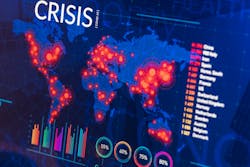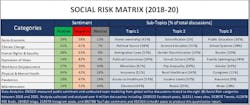Predictive Analytics May Not Be So Predictive
The belief that predictive analytics—data mining, statistical modeling, and machine learning—can accurately forecast trends, behavior, and future outcomes based on historical data is a fallacy. Talk to any experienced risk manager or security professional and they will agree, no one can accurately predict the occurrence of specific event days, months, or years into the future. This, however, has not stopped companies from making significant investments in predictive analysis tools or outsourcing their risk analysis to identify risks and exploit opportunities. In 2016 alone, companies invested approximately $3.49 billion USD in predictive analytics and are expected to invest $10.95 billion USD annually by 2022.
Utility and Application
Predictive analytics is no panacea. It does, however, have utility in specific industries and applications within certain companies. When applied to businesses that perform maintenance and quality assurance, predictive analytics has proven remarkably effective. For example, predictive maintenance models can accurately forecast the chances of essential equipment breaking down while quality assurance models are able to identify and prevent defects in products and services. Risks of this type are knowable—they can be modeled based on facts and measured by variables like the composition of materials or the number of widgets produced.
The healthcare industry has become heavily reliant upon predictive analytics to save money by allocating facility resources, optimizing staff schedules, and identifying high-risk patients. A 2017 report on healthcare industry trends in predictive analytics revealed that 57% of healthcare executives that use predictive analytics believe it will save them 15% or more of their total budget over the next five years. The study also showed that 89% of healthcare executives belong to organizations that are using predictive analytics or plan to do so within the next five years.
Shortfalls and Limitations
COVID-19 is exposing the limitations of predictive analytics in the healthcare industry. Routine medical treatments deferred due to the pandemic generated unexpected savings. However, it also creates uncertainty for hospitals, healthcare providers, and companies’ healthcare plans. Models used to forecast health benefit costs based on patient claims are not able to account for the pandemic or its impact. This leaves companies guessing whether to push for lower premiums based on fewer employee claims or plans for increased costs due to employee medical conditions worsening since they went untreated.
The fundamental challenge with most predictive analytics is their overreliance on algorithms—a process or set of rules that employ mathematical calculations or other problem-solving operations, typically by computers—to solve a specific problem or series of problems. Clustering and regression algorithms are designed to improve customer retention, perform buyer segmentation, create scoring systems, and predict the outcome of time-driven events. Algorithms of this type are unable to account for the multitude of variables required to model human emotion or behavior. Even the most sophisticated predictive analytics that includes neural networks—algorithms designed to identify underlying relationships by simulating the way the mind functions—can not accurately predict how someone decides to act.
Predictive analytics are also heavily dependent on data mining large volumes of different information types to populate their models. Algorithms process structured and unstructured data sets collected from mining tools, reports, social media web scraping, surveys, and polls to detect patterns contained within data. This approach works well for linear or static problems but fails to deliver reliable, accurate predictions when applied to complex problem sets like human decision making, which relies on hundreds of thousands of data points collected over a lifetime of experiences to elicit a certain behavior or action.
Evolving Risk
The majority of risks that companies face today are complex, undefined, and population-centric. Social Risk “exposure to adverse consequences stemming from population-based activities and negative public perception” is a global phenomenon that outpaces traditional forms of risk. It costs companies, on average, 5.7% of their annual revenue, is responsible for the removal of more business and government leaders in the past three years than in the previous thirty years combined and is projected to increase ten-fold over the next five years.
Social Risk is unique to each organization and can manifest from internal and external sources. It includes trending social movements, heightened awareness, the pressure to deliver social impact, demands for accountability, misinformation, executive indiscretions, poor corporate culture, toxic work environments, and uninformed or poorly planned communications, marketing, and community engagement efforts. They are accelerated by social media platforms that amplify socio-economic inequality, extreme ideologies, and race, religion, and gender issues. Companies that ignore these challenges, heighten their Social Risk exposure and put their employees, reputations, and balance sheets in jeopardy.
Predictive analytics like decision trees and regression models are not designed to address Social Risk. At best, when focused on a specific problem set or activity, they provide some indication and warning. However, when applied to Social Risk, predictive analysis tools often create a backlash that results in boycotts, protests, online attacks, and consumer activism.
Innovative Technologies
There are, however, innovative technologies and approaches being developed to address the unique challenges that Social Risks present. Custom-built data collection and analysis platforms combine social listening tools, AI, and machine learning to transform large volumes of data into real-time actionable information. What separates these platforms from typical predictive analysis tools is their population-centric approach, which does not rely on computer-driven algorithms to determine outcomes.
Predictive analytics designed to detect Social Risks combine narrative analysis and topic models to examine how people talk and feel about particular issues, individuals, and events. Sophisticated data analytics platforms analyze the use and placement of keywords, emojis, and phrases contained in ordinary conversations to reveal the identities of individuals. By isolating a single variable “identity” an analyst can accurately measure attitudes, beliefs, and behavior. By analyzing discussions over-time, analysts can identify patterns, anomalies, and changes in beliefs that impact individuals' identities, world views, and ultimately forecast their behaviors.
Case Study
A recent examination of Social Risk measured public perceptions of eight Social Risk categories (Socio-Economic, Climate Change, Human Rights & Equality, Expression of Views, Workforce Empowerment, Physical & Mental Health, Misinformation, and Pandemics) from 2018 to 2020. Analysts collected and analyzed over four million online discussions from 1,208,532 Facebook posts, 316,211 news sites, 503,970 Tweets, 412,978 RSS feeds, 184,816 blogs, 213,978 Instagram posts, 690,788 YouTube comments, and 602,304 LinkedIn posts to measure changes in public sentiment associated with each category. The analysis also examined the three most discussed topics within each Social Risk category and their associated sentiment.A deeper examination of discussions associated with political correctness and cancel culture topics delivers actionable information for decision-makers. Initial discussions expressed support for concepts like respect for individual's opinions, the removal of racist historical symbols, and boycotts of businesses that do not align with trending social issues. Current online discussions, however, express resentment with the destruction of statues and fear of the cancel culture's infringement on personal rights, which are viewed as attacks on personal beliefs. Moreover, activities that were once supported are no longer accepted (e.g. NBA support for #BLM), which also counter industry trends that advance support through donations to organizations that promote social change.
Conclusion
The global risk landscape is continually evolving. Traditional risk models and basic predictive analytics are rendered ineffective when applied to Social Risk. And while some companies have made efforts to adapt, most companies are not prepared or equipped to manage these new threats. Perceived or real, today’s risks pose a new set of challenges for decision-makers. Business leaders and companies must take a practical approach when creating their risk strategies. Rather than making investments in trendy predictive analysis offerings, they should adopt proactive strategies to help identify, manage, and reduce their Social Risk exposure.
About the author: James R. Sisco is the Founder and CEO of ENODO Global. Jim draws upon an extensive military career in US Marine Corps special operations and Naval Intelligence to lead ENODO. He brings to ENODO a unique understanding of risk analysis and a wealth of knowledge and experience in leadership, management, intelligence analysis, strategy development, and counterinsurgency warfare, developed through military operations across the globe where he immersed himself in diverse cultures.
Career highlights include serving as Military Liaison to the Afghan President, supporting the US Director of Intelligence as an authority on Afghanistan, and establishing the US Navy’s Irregular Warfare Office.
About the Author



